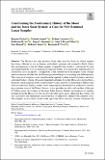Constraining the Evolutionary History of the Moon and the Inner Solar System: A Case for New Returned Lunar Samples
Author(s)
Tartèse, Romain; Anand, Mahesh; Gattacceca, Jérôme; Joy, Katherine H.; Mortimer, James I.; Pernet-Fisher, John F.; Russell, Sara; Snape, Joshua F.; Weiss, Benjamin P.; ... Show more Show less
DownloadPublished version (5.310Mb)
Publisher with Creative Commons License
Publisher with Creative Commons License
Creative Commons Attribution
Terms of use
Metadata
Show full item recordAbstract
The Moon is the only planetary body other than the Earth for which samples have been collected in situ by humans and robotic missions and returned to Earth. Scientific investigations of the first lunar samples returned by the Apollo 11 astronauts 50 years ago transformed the way we think most planetary bodies form and evolve. Identification of anorthositic clasts in Apollo 11 samples led to the formulation of the magma ocean concept, and by extension the idea that the Moon experienced large-scale melting and differentiation. This concept of magma oceans would soon be applied to other terrestrial planets and large asteroidal bodies. Dating of basaltic fragments returned from the Moon also showed that a relatively small planetary body could sustain volcanic activity for more than a billion years after its formation. Finally, studies of the lunar regolith showed that in addition to containing a treasure trove of the Moon’s history, it also provided us with a rich archive of the past 4.5 billion years of evolution of the inner Solar System. Further investigations of samples returned from the Moon over the past five decades led to many additional discoveries, but also raised new and fundamental questions that are difficult to address with currently available samples, such as those related to the age of the Moon, duration of lunar volcanism, the lunar paleomagnetic field and its intensity, and the record on the Moon of the bombardment history during the first billion years of evolution of the Solar System. In this contribution, we review the information we currently have on some of the key science questions related to the Moon and discuss how future sample-return missions could help address important knowledge gaps. Keywords: Earth-Moon system; Lunar evolution; Sample-return; Solar System
Date issued
2019-12Department
Massachusetts Institute of Technology. Department of Earth, Atmospheric, and Planetary SciencesJournal
Space Science Reviews
Publisher
Springer Science and Business Media LLC
Citation
Tartèse, Romain, et al. "Constraining the Evolutionary History of the Moon and the Inner Solar System: A Case for New Returned Lunar Samples." Space Science Reviews, 215 (December 2019): 54. © 2019, The Author(s).
Version: Final published version
ISSN
0038-6308
1572-9672